|
Page < 1 2 3 4 5 6 7 8 9 10 11 12 13 14 15 16 17 18 19 20 21 22 23 24 25 >
Show
in alphabetical order
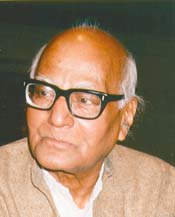 181 Ram
Swarup (1920-1998) a foremost spokesperson of Hindu spirituality and
culture in India. He will probably prove to have been the most influential Hindu
thinker and Hindu Revivalist in the second half of the 20th century. Arun
Shourie has called him a scholar of the first rank. In the 1950s when Indian
intellectuals were singing paens to Marxism and Mao, he wrote critiques of
communism. He
was also an author of several books, Islam
and Christianity, an Imperialist Ideology and
Hinduism vis-à-vis Christianity. 181 Ram
Swarup (1920-1998) a foremost spokesperson of Hindu spirituality and
culture in India. He will probably prove to have been the most influential Hindu
thinker and Hindu Revivalist in the second half of the 20th century. Arun
Shourie has called him a scholar of the first rank. In the 1950s when Indian
intellectuals were singing paens to Marxism and Mao, he wrote critiques of
communism. He
was also an author of several books, Islam
and Christianity, an Imperialist Ideology and
Hinduism vis-à-vis Christianity.
He has observed:
"Hindu dharma was a great reconciler. It
reconciled various viewpoints, various doctrines. It knew how to look at things
from various angles and viewpoints. It knew no conflict between science and
religion, between rationalism and spiritualism. It was so because it was not
dogmatic in reason or religion.
"Hinduism was
organized for peaceful and harmonious co-existence, not for continued
confrontation with external enemies in the shape of unbelievers. It is no
accident of history that though Hinduism knew internal feuds like any social
polity, it never crossed its borders to wage wars against people simply because
they worshipped different Gods. Organized on such non-military
principles, there is no wonder that Hinduism did not even have a name for
itself. "
"In Sanatana Dharma, there is no single life, no
single judgment, or eternal punishment. There is more than one life and of
course, there is no single judgment. In fact, there is no judgment at all as
such, for the idea is to help and to judge and condemn. The inner dynamics of
incarnation is not reward or punishment but self-improvement, and ultimately
self-discovery and self-recovery, moksha."
"Many countries lost all
memory of their past but India has been able to preserve it though in a form
badly damaged. Thus India has come to preserve spiritual traditions which many
ancient cultures and countries have lost. Today
Hinduism represents not only India but the ancient wisdom of humanity and
therefore in a most vital way that humanity itself. In
Hinduism many ancient countries can still rediscover their religious past, their
old Gods and their old spiritual traditions."
(source: On
Hinduism Reviews and Reflections - By Ram Swarup p 1 - 46).
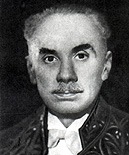 182. Rene Grousset (1885-1952) French art
historian. Author of several books including Civilization
of India and The Empire of the Steppes: A
History of Central Asia. 182. Rene Grousset (1885-1952) French art
historian. Author of several books including Civilization
of India and The Empire of the Steppes: A
History of Central Asia.
He gives a fine interpretation of the image
of Nataraja:
“Whether he be surrounded or not by the flaming
aureole of the Tiruvasi (Pabhamandala) – the circle of the world which he both
fills and oversteps – the King of the Dance is all rhythm and exaltation. The
tambourine which he sounds with one of his right hands draws all creatures into
this rhythmic motion and they dance in his company. The conventionalized locks
of flying hair and the blown scarfs tell of the speed of this universal
movement, which crystallizes matter and reduces it to powder in turn. One of his
left hands holds the fire which animates and devours the worlds in this cosmic
whirl. One of the God’s feet is crushing a Titan, for “this dance is danced
upon the bodies of the dead”, yet one of the right hands is making a gesture
of reassurance (abhayamudra), so true it is that, seen from the cosmic point of
view…the very cruelty of this universal determinism is kindly, as the
generative principle of the future. And, indeed, on more than one of our bronzes
the King of the Dance wears a broad smile. He smiles at death and at life, at
pain and at joy, alike, or rather,..his smile is death and life, both joy and
pain…
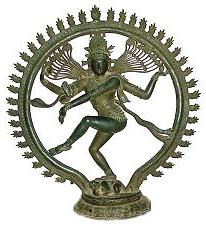 From this lofty point of view, in fact, all
things fall into their place, finding their explanation and logical compulsion.
Here art is the faithful interpreter of a philosophical concept. The
plastic beauty of the rhythm is no more than the expression of an ideal rhythm.
The very multiplicity of arms, puzzling as it may seem at first sight, is
subject in turn to an inward law, each pair remaining a model of elegance in
itself, so that the whole being of the Nataraja thrills with a magnificent
harmony in his terrible joy. And as though to stress the point that the dance of
the divine actor is indeed a sport, (lila) – the sport of life and death, the
sport of creation and destruction, at once infinite and purposeless – the
first of the left hands hangs limply from the arm in the careless gesture of the
gajahasta (hand as the elephant’s trunk). And lastly, as we look at the back
view of the statue, are not the steadiness of these shoulders which uphold
world, and the majesty of this Jove-like torso, as it were a symbol of the
stability and immutability of substance, while the gyration of the legs in its
dizzy speed would seem to symbolize the vortex of phenomena.” From this lofty point of view, in fact, all
things fall into their place, finding their explanation and logical compulsion.
Here art is the faithful interpreter of a philosophical concept. The
plastic beauty of the rhythm is no more than the expression of an ideal rhythm.
The very multiplicity of arms, puzzling as it may seem at first sight, is
subject in turn to an inward law, each pair remaining a model of elegance in
itself, so that the whole being of the Nataraja thrills with a magnificent
harmony in his terrible joy. And as though to stress the point that the dance of
the divine actor is indeed a sport, (lila) – the sport of life and death, the
sport of creation and destruction, at once infinite and purposeless – the
first of the left hands hangs limply from the arm in the careless gesture of the
gajahasta (hand as the elephant’s trunk). And lastly, as we look at the back
view of the statue, are not the steadiness of these shoulders which uphold
world, and the majesty of this Jove-like torso, as it were a symbol of the
stability and immutability of substance, while the gyration of the legs in its
dizzy speed would seem to symbolize the vortex of phenomena.”
(source: The Civilization of the
East – India - by Rene Grousset p. 252 - 53).
He speaks of the Trimurti statue at Elephanta
Caves:
"Universal
art has succeeded in few materialization of the Divine as powerful and also as
balanced. He believed that it is "the greatest representation of
the pantheistic god created by the hands of man."
He concludes with poetic
enthusiasm: "Never have the overflowing sap of life, the pride of force
superior to everything, the secret intoxication of the inner god of things been
so serenely expressed."
(source: The
India I Love - By Marie-Simone Renou p. 88-93).
In the words of Rene Grousset, " The three countenances of the
one being are here harmonized without a trace of effort. There are few material
representations of the divine principle at once as powerful and as well balanced
as this in the art of the whole world. Nay, more, here we have undoubtedly the
grandest representation of the pantheistic God ever made by the hand of
man...Indeed, never have the exuberant vigor of life, the tumult of universal
joy expressing itself in ordered harmony, the pride of a power superior to any
other, and the secret exaltation of the divinity immanent in all things found
such serenely expressed."
(source: The Civilization of the
East – India - by Rene Grousset p.245-6).
In its Olympian majesty, the
Mahesamurti of Elephanta is worthy of comparison with the Zeus of Mylasa or the
Asklepios of Melos."
(source: Civilizations
of the East - By Rene Grousset
Vol. II, p. 245-246).
 He writes about the Indian influence
in South East Asia: "In the high plateau of eastern
Iran, in the oases of Serindia, in the arid wastes of Tibet, Mongolia, and
Manchuria, in the ancient civilized lands of China and Japan, in the lands of
the primitive Mons and Khmers and other tribes of Indo-China, in the countries
of the Malaya-Polynesians, in Indonesia and Malay, India
left the indelible impress of her high culture, not only upon religion, but also
upon art, and literature, in a word, all the higher things of spirit." He writes about the Indian influence
in South East Asia: "In the high plateau of eastern
Iran, in the oases of Serindia, in the arid wastes of Tibet, Mongolia, and
Manchuria, in the ancient civilized lands of China and Japan, in the lands of
the primitive Mons and Khmers and other tribes of Indo-China, in the countries
of the Malaya-Polynesians, in Indonesia and Malay, India
left the indelible impress of her high culture, not only upon religion, but also
upon art, and literature, in a word, all the higher things of spirit."
"There is an obstinate
prejudice thanks to which India is constantly represented as having lived, as it
were, hermetically sealed up in its age-old civilization, apart from the rest of
Asia. Nothing could be more exaggerated. During the first eight centuries of our
era, so far as religion and art are concerned, central Asia was a sort of Indian
colony. It is often forgotten that in the early Middle
Ages there existed a "Greater India," a vast Indian empire.
A man coming from the Ganga or the Deccan to Southeast Asia felt as much at
home there as in his own native land. In those days the Indian Ocean really
deserved its name."
(for more on Greater India refer to chapter on Suvarnabhumi
source: Civilizations
of the East - By Rene Grousset
Vol. II, Chapter - Farther India and the Malay Archipelago p. 275-343).
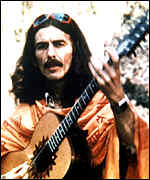 183. George
Harrison (1943-2001) former
Beatle and rocker, who was the impetus for the group's spiritual quest of the 1960s which
brought them to India. In 1965, he
discovered the Indian string instrument, the sitar. Harrison was in India,
to learn how to play the instrument under the renowned sitar maestro Ravi
Shankar. But for some, Harrison brings back memories of a time when the West
turned to India for inspiration and enlightenment. 183. George
Harrison (1943-2001) former
Beatle and rocker, who was the impetus for the group's spiritual quest of the 1960s which
brought them to India. In 1965, he
discovered the Indian string instrument, the sitar. Harrison was in India,
to learn how to play the instrument under the renowned sitar maestro Ravi
Shankar. But for some, Harrison brings back memories of a time when the West
turned to India for inspiration and enlightenment.
One
reason he became interested in India, he was to say in a 1992 interview, was
because "it unlocked this enormous big door in the
back of my consciousness".
Eventually
he became a devotee of Hindu God Krishna, donating large sums of
money to the International Society for Krishna Consciousness and even donating a
23-acre site outside London to the movement. He
also incorporated the trademark Hare Krishna chants in his music. Harrison had
been close to the International Society of Krishna Consciousness since the
1960s. The ISKCON in a statement said, "During his last days, Krishna
devotees were by his side and he left his body to the sounds of the Hare Krishna
Mantra."
(source:
rediff.com
12/01/01).
Harrison
became deeply interested in India. The late George Harrison, a longtime
devotee of Hinduism, left £700,000 to build a temple in the holy city of
Varanasi in India according to Hare Krishna devotees.
(source: BBC
News.com).
His real interest
remained Indian spirituality. In 1976, he told me that the most
influential book he had ever read was Yogananda
Paramahansa’s Autobiography
of a Yogi. “None of this will last,” he repeated. “In the end,
there’s only God-consciousness.”
(source: He
was keener on God than on rock - By Vir Sanghvi Hindustan Times
12/1/01).
George Harrison "Beatle yogi" who
linked Western pop to the strains of the sitar, would have liked himself to be
remembered as the man who spread the message of Indian spirituality to the
decadent West.
(source: Hindustan
Times 12/01/01).
George Harrison, the 'Quiet Beatle' was the most
Indian of the quartet. It was his spiritual yearning that brought the Fab Four
to the banks of the Ganga and to the feet of Maharishi Mahesh Yogi and Pandit
Ravi Shankar. Harrison introduced a whole generation of western performers and
entertainers to Indian music and mysticism following a 1966 visit to Rishikesh
where he drank deeply of ragas and religion.
(source: George
Harrison: The India connection - By Chidanand
Rajghatta Times
of India 12/1/01).
At a time before Westerners were flocking to yoga
classes, Harrison became one of the first proponents of Eastern culture,
studying meditation and Indian music. (source: abcnews.com).
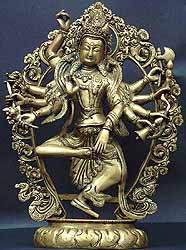 In
1973, he came up with a neatly arranged album aptly titled, Living in the
Material World. The songs reflect the Hindu view of the world and a culmination
of his quest for self-realisation. The song, The Art of Dying for instance,
deals with the philosophy of Karma and reincarnation. He even inculcated in
himself the orthodox-Hindu way of life by waking up at the crack of dawn, bathe
in cold water and study Bhagvad-Gita. In
1973, he came up with a neatly arranged album aptly titled, Living in the
Material World. The songs reflect the Hindu view of the world and a culmination
of his quest for self-realisation. The song, The Art of Dying for instance,
deals with the philosophy of Karma and reincarnation. He even inculcated in
himself the orthodox-Hindu way of life by waking up at the crack of dawn, bathe
in cold water and study Bhagvad-Gita.
(source:
Living
in a yellow submarine - Dailypioneer.com).
He passed away to the sonorous tone of Hare
Krishna chants. He was a lifelong follower of Hinduism
and was closely associated with the Hare Krishna movement. Harrison
had produced the Chants
of India, a recording of Indian religious music. A collection of
mantras and prayers from the Vedas, Upanishads, and other scriptures powerfully
transports the listener to a place of peace where it's possible to be one with
the universe.
(source: Times
of India 12/03/01).
In an Interview,
Henley-On-Thames, Oxfordshire, 1982, this is what the rocker said on His
Personal Spirituality:
"I always felt at
home with Krishna. You see it was already a part of me. I think it's
something that's been with me from my previous birth…. I'd rather be one of
the devotees of God than one of the straight, so-called sane or normal people
who just don't understand that man is a spiritual being, that he has a
soul."
(please refer to Lyrics for
My Sweet Lord, Hare
Krsna Mantra and Govinda).
In
his album Brainwashed,
former Beatle, George Harrison’s answer is “God, God, God”
and we eventually get a reading from How To Know God (The Yoga
Aphorisms of Patanjali) and a chant seemingly called Namah
Parvati performed along with his son Dhani.
It is the perfect
end to a final album of the man who took the world to the feet
of the Maharishi and became Krishna’s
most famous devotee. "Namah
Parvati" was appended it as the album's spiritual
benediction, a touching reminder that while musicians come and
go, music can truly embody their spirit forever.
The
album is dedicated to the Yogis of Hinduism.
(For
more on George Harrison refer to chapter
GlimpsesVI).
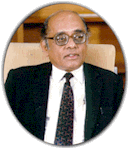 184.
Dr R. Chidambaram
(1936 - ) Principal Scientific
Advisor to the Government of India has said: "Bhagwat Gita" continues
to be the source of inspiration for both Indian and western scientists and
"one sees a thread of similarity in the spiritual thinking of great
scientists like Srinivasa Ramanujan, C V Raman, Chandrasekhar," 184.
Dr R. Chidambaram
(1936 - ) Principal Scientific
Advisor to the Government of India has said: "Bhagwat Gita" continues
to be the source of inspiration for both Indian and western scientists and
"one sees a thread of similarity in the spiritual thinking of great
scientists like Srinivasa Ramanujan, C V Raman, Chandrasekhar,"
He
said Bhagwad Gita has influenced the
thinking of even many foreign scientiss like Erwin Schrodinger and Robert
Oppenheimer.
"I
myself have been influenced by the Saivite religious environment in my family
and the great intellectual force of Advaita Vedanta," he said.
(source:
Hindustan
Times 12/22/01).
185. Houston Stewart
Chamberlain (1855-1927) British born writer, and admirer of music
composer Richard
Wagner. In his major work, The Foundations of the Nineteenth
Century, he
extolled the profundity of Indian philosophy and praise of Hindu
mysticism.
"Indian thought is
unsurpassed in depth and comprehensive many-sidedness."
(source:
The
Soul of India - By Amaury de
Riencourt p 276-279).
 186.
Christopher W.
B. Isherwood (1904-1986) Translator, biographer, novelist, and
playwright, he is the author of over twenty books, including Vedanta for the
Western World and My Guru and His Disciple
- a book about Swami Prabhavananda, who guided Isherwood for some
thirty years. During the 1940s his interests
turned from Christianity to Hinduism. With his guru Swami Prabhavananda
Isherwood translated from the Sanskrit The
Bhagavad-Gita and The Yoga Aphorism of
Patanjali. Isherwood broke from the strictly chronological format to
create a spiritual autobiography wherein the values of Vedanta Hinduism counter
his life as a Hollywood scriptwriter. 186.
Christopher W.
B. Isherwood (1904-1986) Translator, biographer, novelist, and
playwright, he is the author of over twenty books, including Vedanta for the
Western World and My Guru and His Disciple
- a book about Swami Prabhavananda, who guided Isherwood for some
thirty years. During the 1940s his interests
turned from Christianity to Hinduism. With his guru Swami Prabhavananda
Isherwood translated from the Sanskrit The
Bhagavad-Gita and The Yoga Aphorism of
Patanjali. Isherwood broke from the strictly chronological format to
create a spiritual autobiography wherein the values of Vedanta Hinduism counter
his life as a Hollywood scriptwriter.
"I believe the Gita to be one of the major
religious documents of the world. If its teachings did not seem to me to agree
with those of the other gospels and scriptures, then my own system of values
would be thrown into confusion, and I should feel completely bewildered. The
Gita is not simply a sermon, but a philosophical treatise."
(source: Living
Wisdom: Vedanta in the West - Pravrajika Vrajaprana (Editor)
Essay on Gita and the War - By Christopher
Isherwood 93-99).
Turning from Christianity to Hinduism In 1943 he
became follower of Swami Prabhavananda, producing several works on Indian
Vedãnta in the following decades.
187. Dr. D. T. Suzuki
(1870-1966) Japanese Buddhist and Zen scholar, who has written
several books, including Zen Buddhism and Its Influence on Japanese Culture
(1938, rev. ed. 1959), An Introduction to Zen Buddhism. He has said:
"The study
of Japanese thought is the study of Indian thought."
(source: India: Mother
of Us All - By Chaman Lal p. 25).
188.
Rizwan Salim (
? ) reviewer, New York Tribune, Capitol Hill reporter, Engineering
Times, assistant editor, American Sentinel, published in Hindustan
Times has
wisely observed:
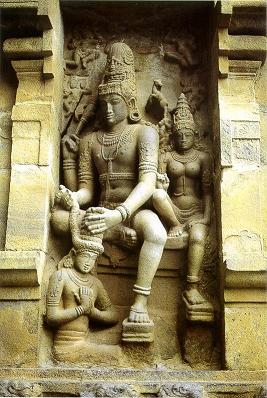 "Given
the reality that Hindustan is the longest surviving
ancient civilization and Hindus have to their credit so many unaccountable and
such astonishing achievements of architecture and painting, music and
dance, poetry and drama, epics and narratives, intellectual systems and
philosophical doctrines, healing systems and mind-body disciplines, Hindus of
every caste and class today should have possessed a well-informed and
well-developed, intense and, fully conscious cultural pride. "Given
the reality that Hindustan is the longest surviving
ancient civilization and Hindus have to their credit so many unaccountable and
such astonishing achievements of architecture and painting, music and
dance, poetry and drama, epics and narratives, intellectual systems and
philosophical doctrines, healing systems and mind-body disciplines, Hindus of
every caste and class today should have possessed a well-informed and
well-developed, intense and, fully conscious cultural pride.
But
one of the principal tragedies of contemporary India is that the majority of
even the educated and otherwise affluent Hindus do not possess a deep and
extensive knowledge of their culture-and do not give evidence of an intensely
felt cultural pride.' Lacking profound cultural knowledge and intense cultural
pride, India's intellectuals regard the fashionable ideas and ideologies from
Europe and America as unquestionably superior to Bharat's thousands of
years old Hindu culture and wisdom."
There are not very many scholars of high ability
and international reputation in India today who illuminate Hindu culture and
Hindus' past great accomplishments. It is an embarrassing truth that the best
Indologists are found in the Netherlands and Sweden, Germany and France, Japan
and Italy-not in Delhi and Ujjain, Varanasi and Puri, Madurai and Mysore."
"It is clear that India
at the time when Muslim invaders turned towards it (8 to 11th century) was the
earth's richest region for its wealth in precious and semi-precious stones, gold
and silver; religion and culture; and its fine arts and letters. Tenth century
Hindustan was also too far advanced than its contemporaries in the East and the
West for its achievements in the realms of speculative philosophy and scientific
theorizing, mathematics and knowledge of nature's workings. Hindus of the early
medieval period were unquestionably superior in more things than the Chinese,
the Persians (including the Sassanians), the Romans and the Byzantines of the
immediate preceding centuries. The followers of Siva
and Vishnu on this subcontinent had created for themselves a society more
mentally evolved - joyous and prosperous too - than had been realized by the
Jews, Christians, and Muslim monotheists of the time. Medieval India,
until the Islamic invaders destroyed it, was history's
most richly imaginative culture and one of the five most advanced civilizations
of all times."
The
descendents of those who built the magnificent temples of
Bhojpur and Thanjavur,
Konark and Kailas, invented mathematics and urban surgery, created mind-body
disciplines (yoga) of astonishing power, and built mighty empires would almost
certainly have attained technological superiority over Europe."
(source: Need
for Cultural pride - Revival - By Rizwan Salim The Hindustan
Times 9/20/1998).
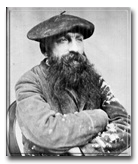 189.
François-Auguste-René
Rodin (1840-1917) French
sculptor, who imbued his work with great psychological force, which was
expressed largely through texture and modeling. He is regarded as the foremost
sculptor of the 19th and early 20th centuries. 189.
François-Auguste-René
Rodin (1840-1917) French
sculptor, who imbued his work with great psychological force, which was
expressed largely through texture and modeling. He is regarded as the foremost
sculptor of the 19th and early 20th centuries.
In a magnificently
poetic outburst about the Mahesamurti (Trimurti)
of the Elephanta Caves:
"This full, pouting mouth, rich in sensuous
expressions, these lips like a lake of pleasure, fringed by the noble,
palpitating nostrils."
(source: Civilizations
of the East - By Rene Grousset
Vol. II, p. 245-246).
Rodin described the statue of Nataraja
or King of Dance -
as the perfect embodiment of rhythmic movement.
(source: Indian
Art - By Vidya Dehejia
p. 12). For
more refer to chapter on Hindu
Art.
He
was overwhelmed when he saw the Chola sculptures in 1913.
"There
are things that other people do not see: unknown depths, the wellsprings of
life," he said.
"There is grace in
elegance; above grace, there is modelling; everything is exaggerated; we call it
soft but it is most powerfully soft! Words fail me then."
(source:
Chola:
Sacred Bronzes of Southern India - By
Joanna Pitman at the Royal Academy
- The Times).
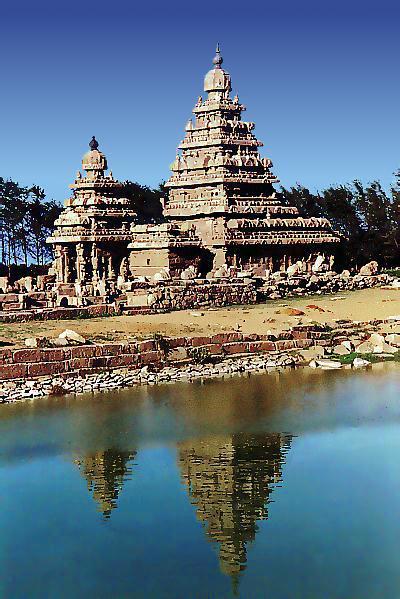
Mallipuram
temple, India.
"The
descendents of those who built the magnificent temples of Bhojpur and Thanjavur,
Konark and Kailas, invented mathematics and urban surgery, created mind-body
disciplines (yoga) of astonishing power, and built mighty empires would almost
certainly have attained technological superiority over Europe."
For
more refer to chapter on Greater
India: Suvarnabhumi and Sacred
Angkor
***
190. Gerald James
Larson, An American scholar who points out
that there are in a manner of speaking almost as many Gitas as there are readers
of it and that:
"What the Gita is, finally is inseparable from its many contextual
environments, ancient and modern, Eastern and Western, scholarly and popular,
corporate and personal, secular and sacred - contextual environments that have
emerged in an on-going historical process and will continue to emerge as that
historical process unfolds." and he adds:
 " An interesting monograph could be written on the Gita as symptomatic of
trends in nineteenth-and twentieth-century European and American scholarly
thought." " An interesting monograph could be written on the Gita as symptomatic of
trends in nineteenth-and twentieth-century European and American scholarly
thought."
( source: The
Universal Gita: Western Images of the Bhagavad Gita a Bicentenary Survey
-
By Eric J. Sharpe
p. 14).
191.
Dorothea
Chaplin mentions in her book,
Matter,
Myth and Spirit or Keltic and Hindu Links
(pp. 168-9),
"Long before the year 460 B.C. in which Hippocrates, the father of European
medicine was born, the Hindus had built an extensive pharmacopoeia and had
elaborate treatises on a variety of medical and surgical subjects...The Hindus'
wonderful knowledge of medicine has for some considerable time led them away
from surgical methods as working destruction on the nervous system, which their
scientific medical system is able to obliviate, producing a cure even without a
preliminary crisis."
(source: Matter,
Myth and Spirit or Keltic and Hindu Links -
By
Dorothea
Chaplin p. 168-9).
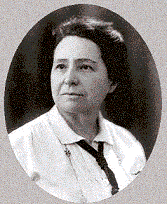 192.
Alexandra David-Neel
(1868-1969)
French explorer, writer, Orientalist and mystic. She had studied Sanskrit and
Buddhism at the Sorbonne University and made her first journey alone to India.
Though educated in a convent, she became interested in spiritualism and
theosophy and joined a group with similar interests, one of this group was Mirra
Richard, the future "Mother" of Pondicherry. She had remarked that the role Gods play in
India is remarkable. She
has said: 192.
Alexandra David-Neel
(1868-1969)
French explorer, writer, Orientalist and mystic. She had studied Sanskrit and
Buddhism at the Sorbonne University and made her first journey alone to India.
Though educated in a convent, she became interested in spiritualism and
theosophy and joined a group with similar interests, one of this group was Mirra
Richard, the future "Mother" of Pondicherry. She had remarked that the role Gods play in
India is remarkable. She
has said:
"because the images of statues are like a battery
which is charged over the ages by the adoration of the devotees, who in turn can
draw energy, inspiration, or grace from these statues." She goes on:
"As a battery, the energy in the statue will not get discharged, as long as
the faithful continue to worship it by their adoration." And she concludes:
" Gods are thus created by the energy given out by the faith in their
existence."
(source: Arise
O' India - By Francois Gautier p. 15).
193 Rev. William Robertson
He could not but praise "the ancient and
high civilization of the inhabitants of India."
(source: The Invasion That Never Was
- By Michel Danino and Sujata
Nahar p. 17).
194.
Professor Rudolph Otto (1869-1937
Was associate professor at Göttingen. Eventually he became a professor of systematic theology, first at Breslau in 1915, then at Marburg in 1917.
He is emphatic that the idea of a Son of God is certainly not from Israel....The
figure of a being who had to do with the world, is of high antiquity among the
Aryans....and points back in some way to influences of the Aryan East.
"These materials are found in India, in more primitive forms not merely as
a late period but in the remotest pre-Christian Kausitaki Upanishad."
(source: Eastern Religions and Western Thought - By Sir Sarvapelli
Radhakrishnan.
p. 161).
195.
Sir John Malcolm
(1829-1896) Was the Governor of Bombay and author of A Memoir of Central India including Malwa and Adjoining Provinces and
also worked for the East India Company and he remarked:
"The Hindoo...are distinguished for some of
the finest qualities of the mind; they are brave, generous, and humane, and
their truth is as remarkable as their courage. "
(source: The Invasion That Never Was
- By Michel Danino and Sujata
Nahar p. 17).
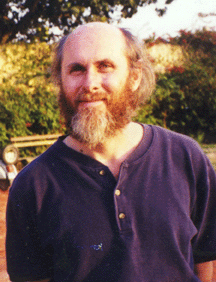 196. David Frawley
( ? ) also known as Pandit
Vamadeva Shastri
the American eminent teacher and
practitioner of Ayurvedic medicine and Vedic astrology and author of several
books, including Arise
Arjuna : Hinduism and the modern world
and Awaken
Bharata: A Call for India's Rebirth -
in which the
need for a new intelligentsia, "intellectual kshatriya" or
intellectual warrior class trained in Vedic dharma, to handle challenges was
emphasized. 196. David Frawley
( ? ) also known as Pandit
Vamadeva Shastri
the American eminent teacher and
practitioner of Ayurvedic medicine and Vedic astrology and author of several
books, including Arise
Arjuna : Hinduism and the modern world
and Awaken
Bharata: A Call for India's Rebirth -
in which the
need for a new intelligentsia, "intellectual kshatriya" or
intellectual warrior class trained in Vedic dharma, to handle challenges was
emphasized.
He writes:
"The Hindu mind
represents humanity's oldest and most continuous stream of conscious
intelligence on the planet. Hindu sages, seers, saints, yogis and jnanis have
maintained an unbroken current of awareness linking humanity with the Divine
since the dawn of history, and as carried over from earlier cycles of
civilization in previous humanities unknown to our present spiritually limited
culture."
"The Hindu mind has a
vision of eternity and infinity. It is
aware of the vast cycles of creation and destruction that govern the many
universes and innumerable creatures within them."
(source: Hinduism
and the Clash of Civilizations - By David Frawley p. 12-13).
A Westerner who has sloughed off the
Western world view, Frawley looks Eastwards, finding in the ancient
Indo-European tradition of the Vedas spiritual nourishment and superior insights
into the moral, environmental and political questions faced by all mankind.
He sees in Western monotheism the basis
for the present commercial monoculture of "globalisation". That is to
say, the singularity and certainty underlying so much of the Judaeo-Christian
mindset is finding new and secular outlets. Those who promote Western notions of
"democracy" and "human rights" above all other forms of
social organisation, who regard "market forces" as all-powerful
(surely a modern superstition) and who wish to impose a politically-correct
blandness on the world are "secular missionaries" as fanatical as
their religious antecedents, if not far more so.
Frawley
values the ancient wisdom of the Vedas above the mainstream Judaeo-Christian
tradition because the latter has falsely enthroned man over nature. The Vedic
tradition, by contrast, is pluralistic and ecologically aware. Frawley,
whose native "civilisation" (the USA ) is ethically challenged, calls
for a renaissance of Indian culture. He believes that there should be a new form
of "truth struggle", or satyagraha, to use Gandhi's word, against the
soul-destroying influence of global monoculture.
He considers Hinduism to be
a religion of the Earth, because, as he describes beautifully:
"…it honors the Earth as the Divine Mother and encourages us to
honor her and help her develop her creative potentials. The deities of Hinduism
permeate the world of nature…they don't belong to a single country or book
only. It is not necessary to live in India to be a Hindu. In fact, one must live
in harmony with the land where one is located to be a true Hindu.
"I see Hinduism as a religion eminently
suited for all lands and for all people because it requires that we connect with
the land and its creatures - that we align our individual self with the soul of
all beings around us. Hinduism finds holy places everywhere, wherever there is a
river, a mountain, a large rock, or big tree, wherever some unusual natural
phenomenon be it a spring, a cave, or a geyser."
"True religion, whether it predominates in
the Eastern or Western parts of the world, is not a matter of geography,"
says Frawley. "All the religions of the world are followed in areas far
beyond the geographical locale of their origin. Religion speaks of the ultimate
issues of life and death and should orient us to the Eternal and the Universal.
In this respect, Hinduism with its universal view has greater relevance for all
human beings than any belief system, which divides humanity into believers and
non-believers."
(source: The
need for a new Indic school of thought
and About.com).
For more refer to chapter on Nature
Worship.
The Indian tradition is
pluralistic and has always offered freedom of worshipping the divine in the name
and form of one's choice and according to one's individual samskaras. It is
pluralistic both at the level of religious practices as well as philosophical
teachings. For this reason we find more religions inside Hinduism than among all
of the world's religions put together.
Pluralism means freedom. It means
that we should accept religious differences as a fact of life, like other
natural variations. We need freedom to arrive at the truth. The pursuit of
dharma, the urge for self-realization and desire for liberation are common to
all paths. Rather than as a cause for confusion, I see Indian pluralism as
constructively facilitating an individual's spiritual quest.
(source: Vedacharya
from the West - Times of India
March 30, 2000).
David Frawley has convincingly argued, the central
value of Hinduism is not “tolerance” (as interested parties try to make
Hindus believe) but truth.
(source: Bharatiya
Janata Party vis-a-vis Hindu Resurgence - By Koenraad Elst
p. 135).
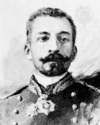 197.
Pierre Loti
(1850-1923) pseudonym of Louis-marie-julien Viaud, a novelist
whose exoticism made him popular in his time and whose themes anticipated some
of the central preoccupations of French literature between World Wars. Loti's
career as a naval officer took him to the Middle and Far East, thus providing
him with the exotic settings of his novels and reminiscences. Some of his books
include Voyages 1872-1913 and L'Inde
sans les Anglais. 197.
Pierre Loti
(1850-1923) pseudonym of Louis-marie-julien Viaud, a novelist
whose exoticism made him popular in his time and whose themes anticipated some
of the central preoccupations of French literature between World Wars. Loti's
career as a naval officer took him to the Middle and Far East, thus providing
him with the exotic settings of his novels and reminiscences. Some of his books
include Voyages 1872-1913 and L'Inde
sans les Anglais.
He expressed his esteem for
India in the following pregnant words: "And
now I salute thee with awe, with veneration, and
wonder, ancient India, of whom I am the adept, the
India of the highest splendor of art and philosophy. May thy
awakening astonish the Occident, decadent, mean, daily dwindling, slayer of
nations, slayer of Gods, slayer of souls, which yet bows down still, ancient
India, before the prodigies of thy primordial conceptions!" (source:
Sanskrit Civilization - G. R. Josyer
International Academy of Sanskrit Research. p. 1)
198. William Edward
Hartpole Lecky (1838-1903) Irish historian, essayist, author of The
Substance of History of European Morals (From Augustus to
Charlemagne).
He quotes an old tradition in Greece that Pythagoras
himself had come to India and learnt philosophy from the
gymnosophists. It seems he believed in an "all-pervading soul" which
is at least one important attribute to Hindu atman. Pythagoras believed in
rebirth or transmigration ; he taught and practiced harmlessness or no-injury,
he taught silence; he taught that the end of man is to "become like
God". Orphic mysteries taught release (lysis) from all material
entanglements, which is close to moksha of the Hindus.
(source: On
Hinduism Reviews and Reflections - By Ram Swarup p. 197).
199.
Paul Hubert,
a French Theosophist, was to write in glowing terms of Charles Wilkins
translation the
Bhagavad Gita. In his book Histoire
de la Bhagavad Gita he said it was one of
the 'striking events in the universal history of philosophy'
(source: The
Universal Gita: Western Images of the Bhagavad Gita a Bicentenary Survey
- By Eric J. Sharpe
p. 4).
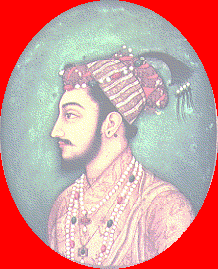 200. Prince Muhammad
Dara Shikoh (1627-1658 AD)
the favorite Sufi son of Moghul emperor,
Shah Jehan. Known the world over for his unorthodox and liberal views.
He was a mystic and a free thinker. Dara Shikoh's most important legacy is
the translation of fifty Upanishads, known under the title of Sirr-i-Akbar
("The Great Secret"). It was completed in 1657, together with
paraphrases and excerpts from commentaries which in various cases, though by no
means throughout, can be traced back to Sankara. 200. Prince Muhammad
Dara Shikoh (1627-1658 AD)
the favorite Sufi son of Moghul emperor,
Shah Jehan. Known the world over for his unorthodox and liberal views.
He was a mystic and a free thinker. Dara Shikoh's most important legacy is
the translation of fifty Upanishads, known under the title of Sirr-i-Akbar
("The Great Secret"). It was completed in 1657, together with
paraphrases and excerpts from commentaries which in various cases, though by no
means throughout, can be traced back to Sankara.
He had learned Sanskrit and studied the Hindu
scriptures in the original. He studied the Torah, the Gospels and the
Psalms, but it is the "Great Secret" (Sirri-i-Akbar)
of the Upanishads which, in his view, represents the most original testimony of
the oneness of God or the Absolute.
His personal fate is well-known: in 1659, two
years after the completion of the Sirr-i-Akbar, he was executed by order of his
brother, Aurangazeb, and with the consent of the Islamic orthodoxy community (Ulama),
who claimed that he was a heretic and a danger to the state, the faith and the
public order.
(source: India
and Europe: An Essay in Understanding - By Wilhelm Halbfass p.
34).
He translated the Upanishads,
Bhagavad Gita and Yoga
- Vashishta into Persian directly from Sanskrit and called it Sirr-e-Akbar
(The Great Mystery). Titled "The
Upanishads: God's Most Perfect Revelation" and then into Latin
by Anquetil Duperron (1801 and 1802) under the title Oupnekhat,
contained about fifty. This translation introduced Western readers to the
Upanishads. Schopenhauer's reaction to it is well-known.
The Quran itself, he said, made veiled references to the
Upanishads as the "first heavenly book and the fountainhead of the ocean of
monotheism."
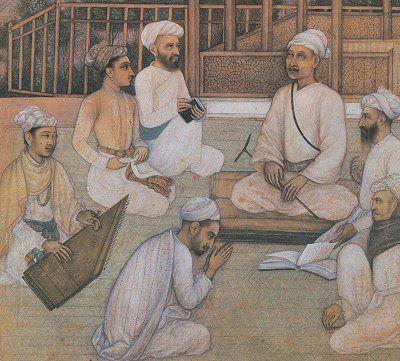
"After gradual research; I have come to the conclusion that long before
all heavenly books, God had revealed to the Hindus, through the Rishis of yore,
of whom Brahma was the Chief, His four books of knowledge, the Rig Veda, the
Yajur Veda, the Sama Veda and the Atharva Veda."
***
Dara Shikoh, wrote in his Persian
translation of the Upanishads.
"After gradual research; I have come to the conclusion that long before
all heavenly books, God had revealed to the Hindus, through the Rishis of yore,
of whom Brahma was the Chief, His four books of knowledge, the Rig Veda, the
Yajur Veda, the Sama Veda and the Atharva Veda."
In his Majma al-Bahrain,
he sought to reconcile the Sufi theory with the Vedanta.
He was able to affirm that Sufism and Advaita
Vedantism (Hinduism) are essentially the same, with a surface difference of
terminology.”
And
in introduction to this work he says that one finds in Upanishads the concept of
tawhid (the doctrine of Unity of God, the most fundamental doctrine of Islam)
after the Qur'an and perhaps the Qur'an refers to Upanishad when it refers to
Kitab al-Maknun (The Hidden Book). His work Majma`ul Bahrayn (Mingling of the
Two Oceans i.e. Hinduism and Islam) is very seminal work in the history of
composite culture of India.
Two years after the completion
of the Sirr-i-Akbar, Dara was executed on the orders of his brother -
Aurangazeb.
(source:
http://ecumene.org/IIS/csss59.htm
and dailypioneer.com ).
Top
of Page
Show
in alphabetical order
Quotes201_220
    
Page < 1 2 3 4 5 6 7 8 9 10 11 12 13 14 15 16 17 18 19 20 21 22 23 24 >
|